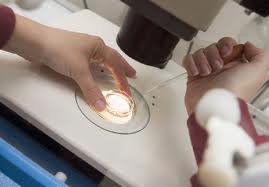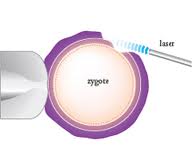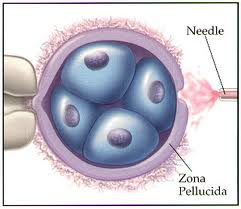The assisted hatching technique was developed in 1990 by a team led by Dr. Jacques Cohen at Cornell University in New York. Since then many IVF centres have adopted this. Although there is some variability in results and technique, most studies on Assisted Hatching have demonstrated that it improves implantation rates in certain patients undergoing IVF and/or IVF/ICSI.
What Is Assisted Hatching?
Assisted hatching is a laboratory technique designed to enhance implantation of embryos generated through in vitro fertilization (IVF). Most people are familiar with the failure of a cycle which is an unfortunate reality of assisted reproduction. Even when presumably high quality, fertile eggs are used, such as in egg donation with surrogates, nearly 40% to half of couples are still left disappointed each cycle. Since most couples are able to get eggs and have fertilization, then the question is where does the failure occur? The answer may be in the implantation phase.
After a fertilized egg is returned to the uterus, several things must happen:
• It must continue to divide and grow (it is now called an embryo).
• The embryo must break out of the zona pellucida (usually called the zona) which is a hard protein shell that surrounds it.
• The embryo must then burrow into the lining of the uterus (called the endometrium) and continue to grow there.
Assisted hatching is a laboratory procedure whereby the zona of the early embryo is mechanically or chemically weakened in a way that assists the embryo to “hatch” from the zona more easily allowing implantation into the lining of the uterus.It has been suggested that making a hole in or thinning this outer layer may help embryos to ‘hatch’, increasing the chances of the woman becoming pregnant in some cases.
For whom is the Assisted Hatching with IVF suitable?
Assisted hatching is thought to be helpful for couples with a poor prognosis whose embryos are thought to lack sufficient energy to complete the hatching process.
According to the American Society for Reproductive Medicine, assisted hatching may be indicated for women with advanced maternal age (older than 38), two or more failed IVF cycles and poor embryo quality. Apart from this Egg quantity and quality factor and Zona factor – cases with embryos that have a thick outer shell also gives indication for the use of Assisted Hatching Technique.
Because assisted hatching is a difficult technique, the success is dependent on the embryologist’s experience and technique, it is important to talk with your fertility clinic about how successful they are with the procedure.
Is Assisted Hatching with IVF Safe?
There can be complications from assisted hatching. It is possible to damage embryos with hatching and lower the pregnancy rates. Therefore, it is essential that if assisted hatching is done, it must be expertly performed by properly trained embryologists. In addition, assisted hatching has been associated with an increased risk of monozygotic (identical) twins.
Views remain mixed as to whether the technique actually improves the chances of pregnancy, but most agree that it may be helpful in selected groups of patients.
Assisted hatching is done while the embryo is in the laboratory. Before being transferred back to the womb a hole is made in the outer layer of the embryo or it is thinned, using acid, laser or mechanical methods. Assisted Hatching using laser technology is probably the best technique. Laser assisted hatching is a gentle and safe way to weaken a part of zona pellucida. Several studies have shown that using a laser is superior to chemical and manual hatching. Miinimal handling of the embryo and delivering fast and exact control over the drilling of the hole are the advantages of laser assisted hatching.
Laser assisted hatching is performed prior to the embryos being transferred back to the uterus.
The actual pregnancy and live birth rates seen in an individual IVF center or infertility clinic will vary according to the hatching technique used, the overall quality of the laboratory, the skill of the individual performing the hatching, the embryo transfer skills of the physician, and other factors.
Assisted hatching of IVF embryos,is an in vitro fertilization lab procedure that can increase IVF success rates,,Ask infertility expert at Rotunda Fertility Center for complete medical advice for infertile couples.
At Rotunda – The Center for Human Reproduction, Laser technique is used to perform the assisted hatching procedure. The team of doctors and embryologist are well adversed with the latesy technology in the field of ART (Assisted Reproductive Technology). You can contact the doctors at Rotunda clinic at http://www.iwannagetpregnant.com or http://www.surrogacymumbai.com/ or at you can have a look at their Assisted Hatching procedure at http://www.rotunda.co.in or simply give a call on +91 22 2655 2000 / 2640 5000 and they will be ready to help you.





 Comments (
Comments ( Category (
Category ( Views (
Views (